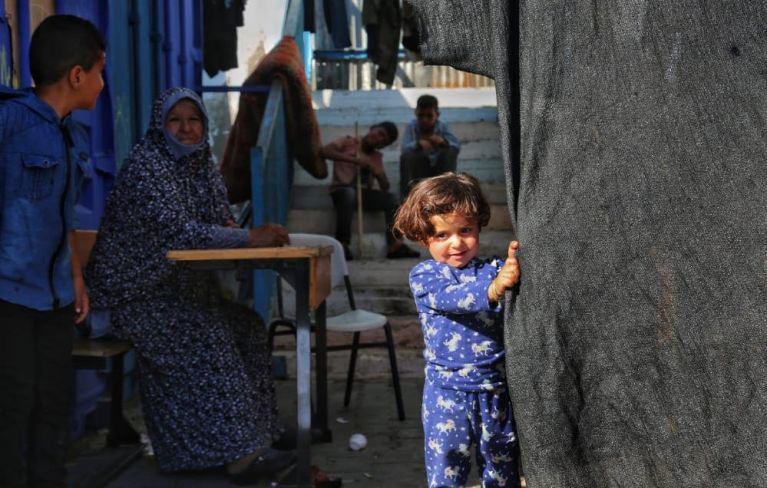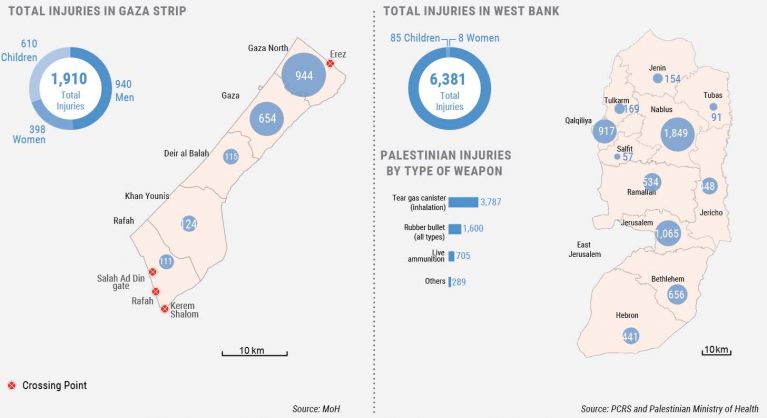Escalation in the Gaza Strip, the West Bank and Israel | Flash Update #11 covering 12:00 20 May – 12:00 21 May
- At 02:00 this morning (21 May), a ceasefire entered into effect between Israel and Palestinian armed groups in Gaza, bringing to an end the hostilities that began on 10 May. As of the time of writing, the ceasefire appears to be holding.
- Some semblance of normality is beginning to return to Gaza, with roads being cleared of rubble and teams working to repair damaged electricity and water lines. The majority of those who sought protection in UNRWA schools and with host families are returning home.
- In the last 24 hours, in the context of hostilities in Gaza, the Office of the High Commissioner of Human Rights (OHCHR) verified an additional 12 Palestinians fatalities, including at least one civilian, a child.1 Nine of these were armed group operatives killed earlier in the hostilities, whose bodies were recovered yesterday. Another 150 injuries were recorded.
- In the past 24 hours, 11 Palestinians were injured in the West Bank, including East Jerusalem, bringing the total number of injuries since 10 May to 6,381.
Key asks
- All sides must maintain the ceasefire.
- Israeli and Palestinian authorities must facilitate unimpeded access for humanitarian relief.
- Israeli and Palestinian authorities must launch investigations, in line with international standards, into alleged violations of international humanitarian law committed during the conduct of hostilities.
- Donors are called on to increase their funding for humanitarian interventions.
Situation overview
Casualties: Gaza and Israel
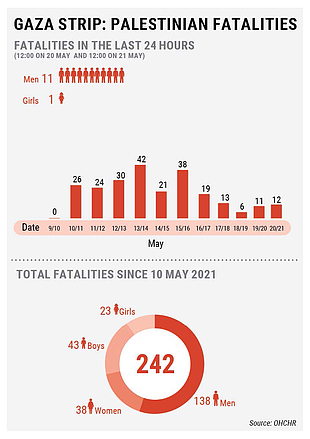 Up to the ceasefire, Israeli forces carried out strikes from the air, the land and the sea across the Gaza Strip, while Palestinian armed groups continued to launch rockets and mortars into Israel. In the past 24 hours, two armed groups operatives were killed when an Israeli missile hit their car while they were travelling west of Jabalia.
Up to the ceasefire, Israeli forces carried out strikes from the air, the land and the sea across the Gaza Strip, while Palestinian armed groups continued to launch rockets and mortars into Israel. In the past 24 hours, two armed groups operatives were killed when an Israeli missile hit their car while they were travelling west of Jabalia.
On the evening of 20 May, the body of a three-year old girl reportedly killed in an Israeli strike of her home on 11 May was recovered. In the morning of 21 May, the bodies of nine people suspected to have been killed in Israeli airstrikes targeting a tunnel east of Khan Younis on 10 or 11 May, were brought to Nasser hospital. Preliminary information indicates that they were armed groups operatives.
Since 10 May, OHCHR has verified that 242 Palestinians, including 66 children, 38 women (of whom four were pregnant) and 138 men, have been killed in Gaza. The overall number includes three people with disabilities, including a child. According to OHCHR, at least 129 of those killed were civilians.2 At least 230, including 62 children, were seemingly killed by Israeli forces. Some of the Palestinian casualties in Gaza may have resulted from Palestinian rockets falling short. At least 14 families in Gaza have lost three or more family members in the same incident, for a total of 77 fatalities.
According to the Ministry of Health, 1,948 Palestinians have been injured, including 610 children, 398 women (of whom three were pregnant) and 940 men since the outbreak of hostilities.
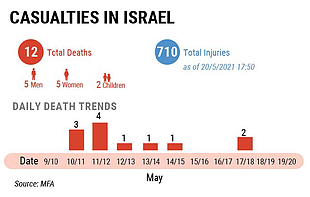 Under international humanitarian law (IHL), only attacks against objects which by their nature, location, purpose or use make an effective contribution to military action or whose destruction offers a definite military advantage are lawful. Targeting civilian objects, including governmental buildings, homes and civilian infrastructure is absolutely prohibited in any circumstances. Attacks against military objects expected to cause a disproportionate harm to civilians or civilian objects are also forbidden.
Under international humanitarian law (IHL), only attacks against objects which by their nature, location, purpose or use make an effective contribution to military action or whose destruction offers a definite military advantage are lawful. Targeting civilian objects, including governmental buildings, homes and civilian infrastructure is absolutely prohibited in any circumstances. Attacks against military objects expected to cause a disproportionate harm to civilians or civilian objects are also forbidden.
In Israel, twelve people, including one soldier and three foreign nationals, were killed by Palestinian rocket or other fire, or when running for shelter during such strikes, and hundreds have been injured since the start of the hostilities, according to Israeli sources.
Indiscriminate launching of rockets and mortars from highly populated in Gaza towards residential areas in Israel violates international humanitarian law.
Gaza
Infrastructure and Services
Hostilities severely damaged essential infrastructure, with the ceasefire permitting repair teams to begin assessing the damage more accurately. According to the Ministry of Public Works and Housing, since the start of the escalation until 12:00 yesterday, 258 buildings, comprising 1,042 housing and commercial units, had been destroyed. In addition, 769 units had been severely damaged, and rendered uninhabitable. An additional 14,536 units had suffered minor damage.
The Education Cluster reports that 53 education facilities, have been damaged since the start of the escalation, with schools in Gaza remaining closed, affecting almost 600,000 children. According to the Health Cluster, up to 12:00 yesterday, six hospitals and eleven primary healthcare centres have been damaged, with one centre suffering severe damage. One hospital is not functioning due to lack of electricity.
Water, sanitation and hygiene (WASH) infrastructure was also severely affected during the escalation, with wastewater networks, pipelines, wells, a wastewater pumping station and service vehicles sustaining damage. Due to damage to feeder lines and networks, the average power supply remains at seven hours a day throughout Gaza. According to the WASH Cluster, due to lack of power supply, three main desalination plants providing drinking water for more than 400,000 people have suspended operation and so have sewage treatment facilities, resulting in more than 100,000 cubic metres of untreated or partially treated wastewater are being discharged to the sea daily. In total, an estimated 800,000 people are lacking regular access to piped water.
Displacement
According to UNRWA, as of 20 May, over 77,000 IDPs were seeking protection in 58 UNRWA schools, including in 23 designated emergency shelters (DES). Following the announcement of the ceasefire, the vast majority are returning home, but about one thousand, whose homes were destroyed or severely damaged still remain. According to the Ministry of Social Development (MoSD), the number of people staying with host families (about 35,000 as of 20 May), has also significantly reduced.
Crossings
The Israeli-controlled Erez passenger crossing, which has been closed since 10 May, remained so, except for a few international humanitarian staff allowed into Gaza today. The Kerem Shalom commercial crossing which has also been closed, except for a few hours on 18 May, will partially re-open today, primarily for the entry of about 50 truckloads of humanitarian goods and 27 truckloads of animal fodder. The Rafah crossing and the Salah Ad Din Gate with Egypt are closed for the weekend. The Israeli authorities have not indicated when they plan to allow the resumption of fishing activity off the Gaza coast, which has been prohibited since the start of the escalation.
West Bank, including East Jerusalem
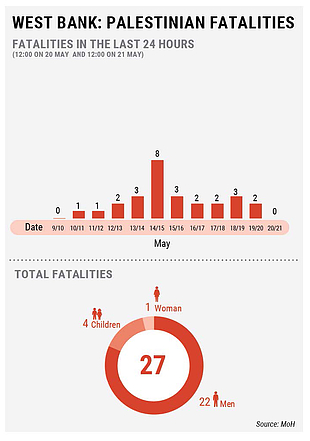 During the reporting period no Palestinian fatalities were reported. The number and intensity of protests and clashes between Palestinians and Israeli forces continued to decline, but 11 people were still injured.
During the reporting period no Palestinian fatalities were reported. The number and intensity of protests and clashes between Palestinians and Israeli forces continued to decline, but 11 people were still injured.
In the context of mass celebrations to mark the ceasefire in Gaza, some fireworks were directed towards Israeli settlements in the H2 area of Hebron, triggering search-and-arrest operations by Israeli forces in Palestinian homes, overnight. Additional search-and-arrest operations were carried out in Ad Dahriyya town (Hebron), Tulkarm city, and Al A’raqa and Jaba villages in Jenin.
In the afternoon of 20 May, Israeli forces raided Al Makkased Hospital in East Jerusalem, fired a sound bomb into the hospital compound and damaged hospital property. This is the third time since 10 May, that Israeli forces have raided the hospital.
Since 10 May, 27 Palestinians have been killed and 6,381 injured by Israeli forces across the West Bank in protests, clashes and attacks. Of all the injuries recorded, about 60 per cent required medical treatment after inhaling tear gas, 25 per cent were hit by rubber bullets and 11 per cent were shot with live ammunition.
Notes
1. Includes those that have died during the past 24 hours due to injuries previously sustained.
2. Those reported as civilians are individuals who are not members of armed forces and were not directly participating in hostilities at the time that they were killed. Whether an individual is qualified as civilian or not, has no bearing on the legality of the killing. Data is based on information from at least three independent and reliable sources at the time of reporting. As further verified information becomes available, the number of fatalities in total, and in any of the categories, may change.
Humanitarian response & ongoing needs
Protection
Gaza: On 21 May, the Gender-Based Violence (GBV) Sub-Cluster (SC), organized another mental health support group session for eight counter-GBV frontline workers and counsellors in Gaza. Most communitybased interventions had been suspended due to the hostilities, including office-based and in-person services and other community education and awareness raising activities. The 12 UNICEF-supported Family Centres are currently not operational but are providing ad-hoc recreational support activities for children. Cluster partners report a devastating mental health impact on children and families, following intense and sustained Israeli shelling, particularly in residential areas: serious physical and psychological symptoms are appearing in children. Partners warn that without rapid psycho-social support, many may develop severe mental health disorders. In addition, there is a continuous concern of explosive remnants of war (ERW) contamination. Furthermore, there is a need for psychological first aid for frontline workers and other people; psycho-social support; non-food items (NFIs) and hygiene kits for IDPs, including dignity kits for women and girls; multi-purpose cash support; and mental health and psycho-social support (MHPSS) for children and parents. Protection partners have produced and disseminated awarenessraising materials and guides on how to support children during crises, including how to watch out of ERWs. They have also provided WASH and psychological counselling. Family Centres are reaching out on ERW awareness raising messaging through existing WhatsApp groups.
West Bank, including East Jerusalem: Cluster partners are monitoring and documenting cases of suspected violations of international law, and providing legal aid and child protection services, as well as MHPSS. Of ongoing concern is the suspected excessive use of force by Israeli forces including live ammunition shot at against protesters and in clashes, including during search and arrest operations. This raises a serious concern of arbitrary arrests and detention and violations of the freedom of expression and assembly. Cluster partners continue to provide remote MHPSS and legal aid for those detained. Partners are recording an increasing demand for legal aid as the frequency of suspected violations related to arrests and detentions, settler violence, excessive use of force and access restrictions is increasing. Cluster partners are reporting a growing number of unmet needs concerning legal aid for victims of Israeli settler violence in East Jerusalem.
Health
Gaza: Cluster partners have conducted a joint COVID-19 infection prevention and control assessment for IDPs in UNRWA schools, aimed at minimizing the risk of COVID-19 transmission. The Ministry of Health (MoH) central laboratory resumed PCR COVID-19 testing, aimed at early detection and treatment of people with COVID-19. Since the start of the hostilities, 18 healthcare facilities have sustained damage, and one NGO hospital is not operating due to shortage of fuel. Partners maintain their response efforts in treating injuries, despite the infrastructural damage which is hindering access to health facilities. The evacuation of injured people remains a challenge, due to damaged infrastructure and rubble. The Palestinian Civil Defense (PCD) reported that since 10 May, a total of 259 ambulance operations, 208 rescue operations and 700 fire extinguish operations had been carried out, However, PCD reported that it lacked the capacity to handle the growing needs for search and rescue, fire extinguishing and other services.
West Bank, including East Jerusalem: As of this morning, emergency medical services were on standby in case of possible clashes in the context of today’s planned ‘day of rage’.
Shelter
Gaza: Partners are assessing the damage and supporting the repair of homes, giving priority to vulnerable groups. According to the Ministry of Social Development (MoSD), 3,071 families comprising 15,831 people have been directly affected.
Water, Sanitation and Hygiene (WASH)
Gaza: During the hostilities, some 93 strikes damaging WASH infrastructure were recorded, resulting in severe damage to WASH facilities and more than one million people having their access to WASH facilities disrupted. Hundreds of thousands of people have limited access to piped water. Cluster partners are coordinating with PWA to support the service providers with emergency maintenance materials and tools to restore the water and sanitation services in the affected areas. The Gaza Coastal Municipality Water Utility (CMWU) and other service providers are applying temporary maintenance measures for the most critical infrastructure to secure minimum WASH services for people in the affected areas.
Education
Gaza: All schools in Gaza remain closed until further notice, impeding access to education for nearly 600,000 students, 51 per cent of whom are girls. Some 53 education facilities have been affected due to the hostilities, with reports indicating that a number were directly hit by airstrikes or tank shells. Cluster partners have been scaling up distance learning support, remote MHPSS, and the delivery of emergency education supplies to displaced children.
West Bank, including East Jerusalem: The Education Cluster expects that schools will re-open on 23 May, pending a decision by the parents’ association on 22 May.
Food Security
Gaza: On 20 May, 420 tons of animal feed entered Gaza through the Rafah crossing, a one-time import from Egypt while the Kerem Shalom goods crossing with Israel remained closed. According to initial estimates by the Ministry of Agriculture (MoA), damage to the agriculture, livestock and fishery sector have reached US$32 million. The heightened risk for farmers and breeders to access their lands and agricultural facilities remained of concern during hostilities; the financial loss of broilers is estimated to exceed 230,000 birds, while thousands of litres of milk were spoiled, in addition to tens of sheep lost and a number of beehives destroyed as a result of the hostilities. For the twelfth day, there is a full closure of the sea, leading to the complete disruption of fishing activities and daily affecting 3,600 fisher households. The World Food Programme (WFP) has supported 95,955 people affected by the ongoing crisis. The distribution of ready-to-eat food to UNRWA shelters is on hold as of the morning of 21 May, since many IDPs are returning to their homes. Some deliveries to shelters took place and fresh bread will be redirected to 200 WFP-contracted local shops across Gaza.
